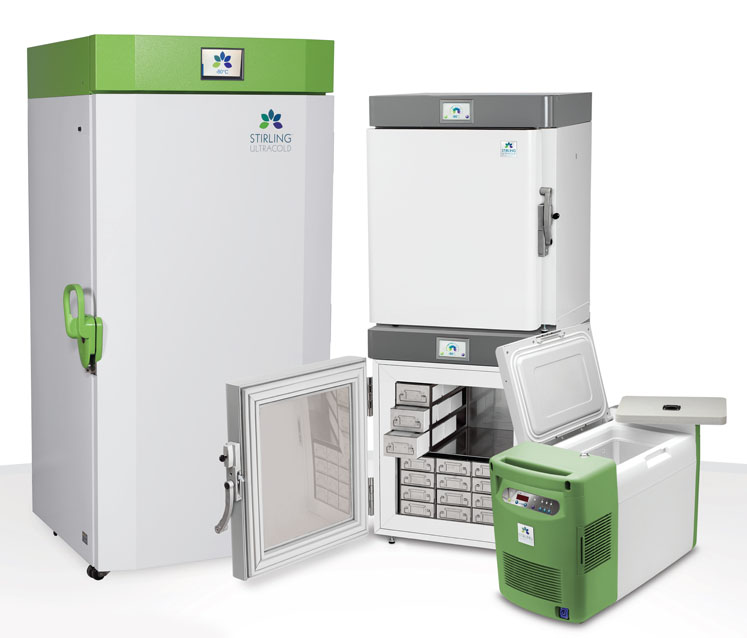Having discussed the issues facing the pharmaceutical supply chain in Part I, I ask Dusty to tell me more about the solutions on offer from Stirling Ultracold.
DT: As we’ve been directly involved with putting freezer farms together, I’d like to hone in on the last mile. The Stirling platform, as used by UPS, provides a significant number of operational storage benefits, such as a small footprint, large capacity, low heat output, high reliability and very low energy consumption.
Ironically, modern freezers often use 10–15 times more energy than may have been used in the past. Stirling’s mission was to address that fact; it’s how the company was born and we remain committed to optimising energy efficiency and sustainability. It’s a big part of how we position ourselves in the market.
As such, we have three products: one that’s ideal for freezer farms (SU780XLE), a 105 L system that fits underneath a counter (SU105UE) — making it ideal for space limited environments such as clinics and health offices around the world — and a 25 L model that is highly portable and readily transportable to support mobile needs and localised storage requirements.
All these devices can be set to operate at a temperature anywhere between –20 and –86 °C. So, as manufacturers start to consider their storage needs, they sometimes end up looking at multiple systems to support a range of temperatures.
The great thing about a Stirling system is its ability to store vaccines or biological materials at any set point between –20 and –80 °C, all within the same product. All of these freezer systems can work together to maintain the cold chain, keeping in mind that the ULT25, an igloo-like cooler system, is ideal for the last mile transport, distribution and storage of vaccines.
We believe we offer the only transportable unit in the pharma space that actually provides the range of temperatures that we’re talking about here.
If you take a 2 mL vial, for example, the so-called standard format box can store roughly 1800 vials. And, assuming there are five doses per vial, that’s 9000 injections. This device can be put in any vehicle and it comes with an adaptable lead that can plug into almost any 110/240-volt power port/source in the world.

If you think about a regular Amazon delivery truck stocking up at a warehouse or a freezer farm, the Stirling device can be filled with vaccines and act as a mobile storage solution as the lorry shuttles between the freezer farm and various clinics, pharmacies and regional health centres.
To add some perspective, let’s look at the alternative: dry ice. Dry ice requires special PPE such as a face shield, gloves, long-sleeved lab coats, etc. And, as we all know, this stuff is basically solid carbon dioxide (CO2). It boils off, it causes burns and actually consumes oxygen, which is not a good thing!
Many centres, whether they’re in cities, towns or more rural locations, are just not equipped to handle dry ice. A solution such as ours is much easier to use — like plugging in a coffee machine — and benefits from a unique racking design to assist the entire vaccination procedure in a clinical environment.
We also believe that these devices have many different applications, especially as biologics come to the fore. It’s much more than a one-and-done application; it will help to establish the future supply chain infrastructure for the next wave of personalised medicines.
RG: To echo that point, I think Dusty has nicely summarised the reasons why we selected Stirling products for our vaccine requirements … and as our freezer of choice going forward. We have the world’s largest academic biorepository, so it’s imperative that we store our samples very safely.
The high capacity, low footprint and much improved energy consumption provide significant advantages; but, possibly more importantly is the reduced heat load. Putting a piece of equipment to a purpose-built building is one thing, but adding freezers into normal laboratory spaces is very different.
The benefit of Stirling freezers is that they use a standard power supply, they generate less heat and, as such, they’re easier to accommodate within a regular laboratory environment. We are using a variety of devices for both vaccine storage and distributions.

Sometimes the transition from receiving the vaccines from storage to administration at local sites can be problematic, but not with the ULT25. Because we’ve elected to go with the Stirling solution, we can now use small vans for vaccine transport. There would have been issues with dry ice in those confined spaces.
KSR: Another issue that’s high on the supply chain agenda is security, making sure that what leaves the freezer farm is what is delivered to the patient when it comes out of the van. How does your solution help with this?
DT: The key thing, Kevin, is that vaccines need to be maintained according to the manufacturer’s specifications. From our standpoint, we have a device that does a couple of things: first of all, it maintains the required temperature of the vaccine.
We’ve already discussed the multipurpose power cord and the fact that the ULT25 can even be charged inside a moving vehicle. It’s critical to note that if there’s any deviation outside strict temperature tolerances, the vaccines will be lost. With dry ice, it’s difficult to control that essential parameter.
In addition, another aspect of our device is the onboard computer; this basically provides evidence that the temperature is being maintained (the data can subsequently be downloaded with either an ethernet cord or a USB memory stick).
On top of that, we also have a device that offers remote monitoring — called SenseAnywhere — that plugs right into our system and provides a complete record of the fact that the vaccines in the box were kept at the designated temperature until they reached the pharmacy or clinic.
We can prove cold chain custody, which is what I refer to as security. That’s not an easy feat to accomplish, but we’ve got a device that actually helps to ensure the ultimate security of the pharmaceutical cold chain.
Summing up
Adding the final word, Dusty observed that although a lot of attention has been focused on getting a vaccine to the point whereby we can manufacture it and establishing mid-level infrastructure aspects of getting freezer farms running, ensuring available capacity, etc., he feels that shedding some light on the challenges of actually delivering a viable therapeutic to patients warrants more exposure.
“The last mile is really what it’s all about,” he enthuses, “particularly in a world that’s never experienced ultra-low temperature vaccine requirements. It’s going to be an important segue.”
